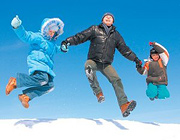To Your Health
December, 2007 (Vol. 01, Issue 12) |
|
|
Winter Warm Up
By Meghan Vivo
"It's too COLD.
I'll get SICK.
I might SLIP and FALL."
All common excuses for avoiding exercise when the seasons change. With four to six months of winter in many parts of the country, you can't afford to skip winter exercise altogether. For both physical and mental well-being, the human body needs activity all year round. Whether you find creative ways to exercise indoors or dive into the great outdoors, maintaining an exercise regimen through the holidays and beyond will not only keep you fit, but also give you a head start come spring.
Take It Outside
If you don't want to stay cooped up inside for months, exercising outdoors can be a great way to stay in shape while appreciating the sights and sounds of winter. From snowball fights and sledding to snowshoeing and cross-country skiing, a host of outdoor activities await you. Of course, if you have any medical conditions or concerns about outdoor exercise, check with your doctor first. Here are a few tips to help make the most of your time outdoors:
- Dress for the Cold. Layered clothing is essential when exercising in cold weather. The base layer should be a thin layer of synthetic material like polypropylene (such as Gore-Tex), which lets sweat evaporate away from your body. Next, wear a layer of fleece or similar material for insulation. The outer layer should be made of waterproof, wind-repellent, breathable fabric to let the heat out and keep the cold air from coming in. Since as much as 50 percent of heat loss comes from the head and neck, a hat and gloves are necessities. To warm the air before you breathe it, use a scarf or mask.
-
 Protect Your Skin. Winter weather brings cold, wind and humidity - all of which wreak havoc on your skin. The snow reflects the sun's rays, making sunburn possible even in the winter months. A basic regimen of sunscreen and moisturizer can protect your skin from harsh conditions.
Protect Your Skin. Winter weather brings cold, wind and humidity - all of which wreak havoc on your skin. The snow reflects the sun's rays, making sunburn possible even in the winter months. A basic regimen of sunscreen and moisturizer can protect your skin from harsh conditions. - Drink Fluids. When the air feels colder, you are less likely to realize you're thirsty. The drying effect of cold air actually increases the risk of dehydration, which in turn increases the risk of frostbite. So drink water before and after your workout, even if you don't feel thirsty.
- Beware of Wind Chill. The wind chill factor can be a serious problem for outdoor-fitness buffs. Start your workout into the wind and finish with it behind you (when you're sweaty) to avoid getting chilled. Fast motion such as skiing, running, cycling or skating can create wind chill because it increases the movement of air past your body. For example, if the temperature is 10 F and the air is calm, skiing at 20 miles per hour creates a wind chill of minus 9 F. If the temperature outside is well below zero or the wind chill is below minus 20, experts advise choosing an indoor activity instead.
- Dont't Push Your Luck. Sometimes you need to know when to get out of the cold. Exercising in the snow can be invigorating, but ice is treacherous and almost impossible to see, especially when it's on pavement. In icy conditions, move your favorite activities indoors. If you're out in severe conditions and notice you have a patch of hard, pale, cold skin, you may have frostbite. Slowly warm the affected area and seek emergency care if numbness continues. If you experience intense shivering, slurred speech, loss of coordination and fatigue, you may have hypothermia and should immediately seek emergency care.

